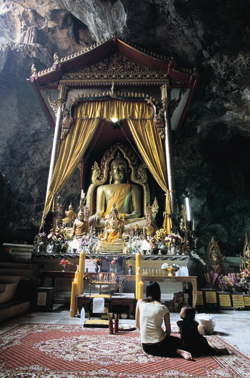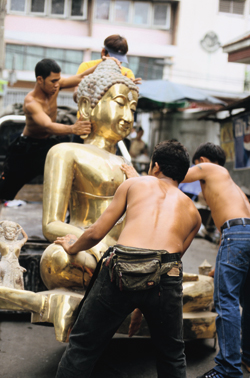
MY FIRST venture into learning Theravada-style meditation was through a New York Insight Meditation Center class, held in a barren room in a nondescript building in a dreary Manhattan neighborhood.
While I enjoyed the sessions, the setting was a far cry from the gilt-covered temples of my ancestral Thailand, where ornate prayer halls are graced with tier upon tier of golden Buddha statues, and the grounds teem with saffron-robed monks and lay devotees.
Since I was a child, I have always been fascinated by these temples, not only because of their razzle-dazzle, but also because they brought Buddhism to such vivid, tangible life. Although my parents were Thai and I was raised Buddhist, I was born and grew up in the devoutly Catholic Philippines and later attended university and worked in the United States. I occasionally visited temples on annual trips to Thailand, but the Buddhism I knew came largely from books.
While living in the States, I practiced with Western Buddhist groups. I found nourishment in my practice, but part of me wondered about that extra something a native Buddhist culture could offer. I wanted to experience life in a place where Buddhism was not confined to a practice center or section of the library, but permeated the culture and everyday life. I was also not entirely comfortable with the way many Westerners approached Buddhist practice, focusing on individual inner experience—meditation, mindfulness, and personal transformation—and de-emphasizing the “outer trappings” of religion—rituals, institutions, and doctrines.
What Western Buddhists preferred to leave out of their practice, I hankered for: colors, textures, smells, emotions, and community bonding. In my fantasies of Thai Buddhist life (borrowed heavily from glossy travel guides), I would join the crowds of pious locals to give alms to the monks streaming through the streets every morning. I’d spend Buddhist holy days taking part in special rites and charming festivals, filled with candles and flowers and lively parades.
But when I moved from New York City to Bangkok in 2003, I found that reality didn’t quite match the fantasy. To start with, in my residential street dotted with high-rise condominiums and an auto shop, only one monk came on alms round and just a handful of neighborhood people showed up to make offerings. Rather than celebrate major Buddhist holidays by making offerings, listening to sermons, and circumambulating the temple grounds, most people preferred to hit the mall.
Surprisingly, some people I knew who considered themselves committed Buddhist practitioners went to temple only if it was convenient; they didn’t consider it a fundamental part of their practice. For these less traditional types, the benefits of going to temple weren’t enough to justify the time and effort. As one friend in her thirties told me, “I prefer to use my time to meditate. That’s the best way to celebrate a holy day and pay respects to the Buddha and his teachings.”

This woman was typical of a certain subculture of contemporary Thai Buddhists from urban, educated, middle-to-upper-class backgrounds, which I was intrigued by and later wrote my master’s thesis on. Generally speaking, they are characterized by a streamlined, no-frills approach to Buddhist practice. Intent on reaching the “real heart” of Buddhism and developing liberating insight, they consider meditation the cornerstone of practice. They go on retreats, meditate regularly, and emphasize developing mindfulness in daily life. Many are also interested in deeper study of Buddhist texts. They tend to give less priority to rituals, traditional merit-making acts, and chanting, which they consider peripheral acts. In fact, the outlines of their Buddhist practice were not all that different from that of Western Buddhists. Many in fact had become interested in Buddhism only after studying in the West.
This new focus on meditation seems to reflect both these practitioners’ more intellectual bent as well as a growing sense of spiritual empowerment. Traditionally, Buddhist teachings for Thai laypeople emphasized the importance of following the five precepts and practicing generosity (especially through donations to monks). Meditation training was largely considered the purview of monks. However, many of the lay practitioners I spoke with were interested in deeper practice and expressed great confidence in their spiritual capabilities. Not content to simply accumulate merit for a good rebirth, they told me, they were working towards achieving nirvana—the more ambitious aiming to do so in the fewest lifetimes possible, or even in this lifetime. One twenty nine-year-old owner and manager of a successful retail company—a well heeled yuppie from all outward appearances—explained, “It’s so rare to be born as a human and be able to practice dharma, so I ought to take advantage of this life and try to finish the job.”
I found this dedication admirable, but I wondered if, by making their individual inner experience paramount, these urban Thais were losing sight of community. The traditional Thai model of religious community—a village centered around the local temple—is almost impossible to find nowadays in industrialized and urbanized Bangkok. Still, religious community life hasn’t dried up completely. It has, however, taken new shapes. I discovered that urban practitioners are creating their own vibrant communities, the modern twist being that many are almost entirely composed of, and organized by, laypeople. One lay group is associated with the Foundation for the Promotion of Vipassana (as taught by S.N. Goenka). Alumni of the Foundation’s ten-day retreats organize weekly group sittings, attend monthly committee meetings, and serve as volunteer staff on retreats. The Sangha of Mindfulness, a group composed of lay practitioners who met at retreats led by Plum Village monastics in Thich Nhat Hanh’s lineage, meets regularly for group practice sessions. Other lay groups are oriented around local monks and nuns, who continue to serve important roles as teachers. Now, though, adherents maintain connections with individual teachers, rather than with full-fledged monastic communities. Teachings usually take place in non-temple spaces, such as dharma centers, meditation hermitages, or even resorts. Thanks to online networking via web boards and mail groups, virtual communities are also a growing resource for practitioners. Among the liveliest Thai-language websites is larndham.net, where hundreds of Buddhists converge to post and answer questions about Buddhist teachings and share information about events throughout Thailand.

Perhaps the most truly modern aspect of these new communities is the fluidity with which one can move among them. Like many other Bangkokians, I’ve been able to explore and participate in several different communities, both overlapping and distinct. While the groups I initially practiced with may have been more laicized and non-traditional, they make up only a small minority of a much broader spectrum of Buddhist practice that thrives in Thailand. It is still fairly easy to tap into more traditional forms of practice. I’ve accompanied friends to temples in provinces near Bangkok to make donations, and to get my chanting fix, I sometimes join a group of professors and students at my university who meet weekly during the lunch hour. I’ve also gone to stay at temples in rural Thailand, where I was able to have a taste of the old village temple connection. At the same time, I continue to go on meditation retreats and visit lay practice centers.
Living in Thailand has been special in allowing me to have access to all of these various aspects of practice. As one of my teachers, Ajahn Jayasaro (an English born monk ordained in the Thai Forest tradition) points out, Thailand’s multifaceted religious culture had developed in order to answer the needs of the whole person—not only intellectual but also emotional. Drawing from this rich nexus has brought a greater depth, fullness, and balance to my practice.
While immersed in the diversity of Thai Buddhist life, I’ve also kept up ties with the groups I’d practiced with abroad through virtual links and occasional visits that help sustain my sense of belonging to a global Buddhist community. I still value what I’ve learned from the more intellectual approach of modern Western Buddhists—for instance, looking for the underlying purpose and meaning of a Buddhist ritual, rather than simply performing it as a matter of tradition. Reflecting back, I think I was unconsciously seeking this balance when I came to Thailand. If Buddhist practice involves balancing a variety of elements skillfully, I’m grateful for the contributions my experiences around the world have given me. Eventually, I hope I’ll develop the dexterity to achieve a good balance—no matter where I happen to live.
Thank you for subscribing to Tricycle! As a nonprofit, we depend on readers like you to keep Buddhist teachings and practices widely available.